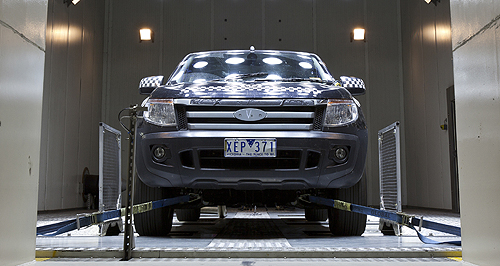Make / Model Search
News - FordAussie Ford employees involved in self-driving futureStriker Eureka: Ford Australia’s boss Graeme Whickman (left) has confirmed that the local development team will contribute to the advancement of the Blue Oval’s first fully autonomous vehicle due in 2021. Australian employees will aid in development of Ford’s first autonomous vehicle31 Mar 2017 By TUNG NGUYEN FORD Australia president and CEO Graeme Whickman has revealed that the company’s local employees will have a hand in developing the Blue Oval’s self-driving vehicles of the future, with the first autonomous model expected to come to market by 2021. Speaking to GoAuto at a special Future with Ford presentation in Melbourne, Mr Whickman confirmed that the input of the local research and development (R&D) team would be “large”. “I mean they led the global development of the Ranger, they led the global development of the Everest, those vehicles have semi-autonomous driver assist technologies that are significant already,” he said. The technologies featured on some versions of the Everest and Ranger include adaptive cruise control, hands-free self-parking capability, pre-collision warning with pedestrian detection, lane keep assist, lane departure warning and a driver fatigue warning – all of which form the underpinnings for a driverless vehicle and count as semi-autonomous systems. Mr Whickman said Australia’s status as the Asia Pacific Product Development Centre and the resources it has at its disposal gives the local team a unique opportunity to work on products that will be offered around the world. “Well the team here, there are about 1715 designers and engineers, and we have a proving ground, we have a design studio, we have an R&D centre, we have a very big footprint, and yes, they’re working on vehicles that you will see on the roads around the world in the next number of years. “We just added a $50 million investment into Australia this year to expand facilities like the proving ground and driver assist technology testing capabilities, on top of the $450 million we’re investing this year in R&D. “So without disclosing exact product, I think it’s fair to say as one of only three PD (product development) hubs with experience already in semi-autonomous, those folks will work alongside their global counterparts to deliver products that we’re talking about.” The aforementioned safety technologies found in the Ranger and Everest are enough to classify both as level two autonomous vehicles under the Society of Automotive Engineers (SAE), with plans currently underway for Ford to develop a vehicle that would fall under the level four classification – a self-driving automobile with no steering wheel or pedals. Ford revealed a new autonomous development vehicle based on its US-market Fusion model late last year, with plans to bring its self-driving test fleet to 90 by the end of this year. The first autonomous development Ford Fusion vehicle first began trials in 2013 and uses a series of cameras, sensors and Lidar to gather data about the world around itself, but while the self-driving hardware has moved steadily ahead since then, Mr Whickman explained that bringing a fully autonomous car to market is now about the collective social issues that need to be addressed. “There is a quantity of things that need to be settled and resolved and not all of them are in place right now, but we have faith they will be because of the… compelling reasons why we need to do this,” he said. “And some of those are economic and some of those are societal, and so, as long as people keep that in their minds, we will find a way. “There will be a way through this, and I don’t think it will be easy, because nothing worthwhile comes easy, but it will come and it’s just going to take perseverance and durability and engagement.” Despite the many hurdles facing Ford to bring its autonomous vehicle to market – including ethics, government and regulations – Mr Whickman said the effort will be well worth it if it means lives can be saved. “If you contemplate the facts, 90 per cent of accidents right now involve human error,” he said. “So being able to reduce that immediately has got to generate, I think, interest in anybody around the improvement you could deliver straight way. “If we want to be a thought leader, somebody right on the edge of innovation, then we need to be prepared to actually have and promote those types of dialogues.”  Read more30th of March 2017  Autonomous vehicle benefits far outweigh risks: FordFord expects self-driving teething problems, but tech still safer than human drivers30th of March 2017  Ford’s future focuses on drivers as well as driverlessSelf-driving solutions for the future does not mean forgetting the driver: Ford |
Click to shareFord articlesResearch Ford Motor industry news |










Facebook Twitter Instagram